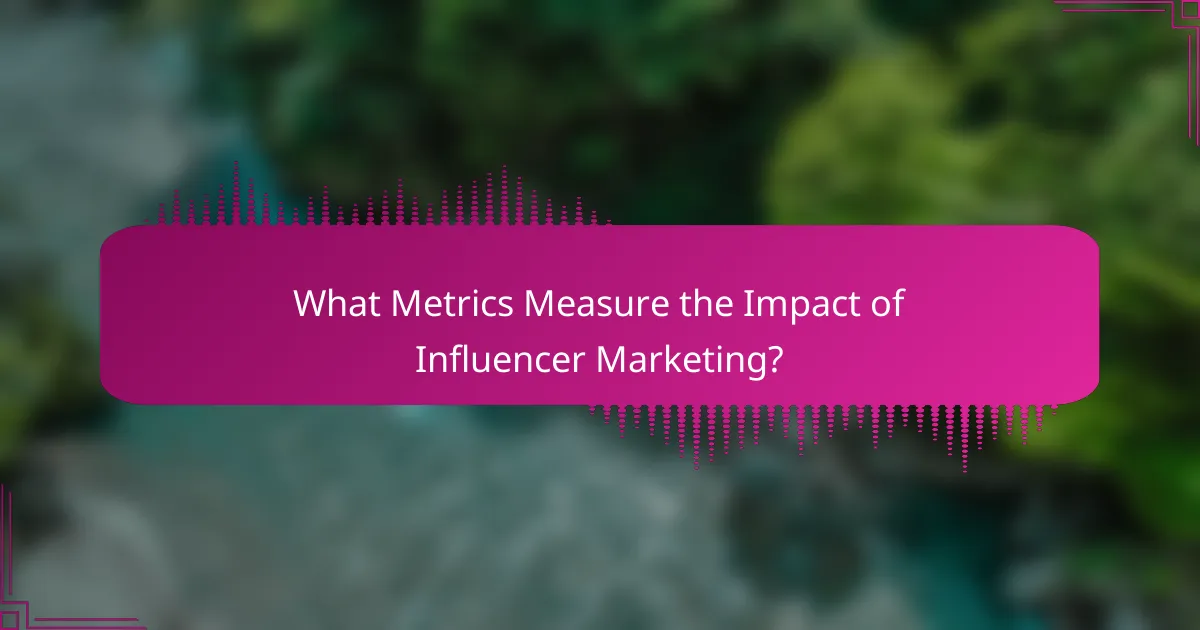Influencer marketing has become a pivotal strategy for brands seeking to connect with their target audiences effectively. Selecting the right influencer involves aligning values and understanding audience demographics, while successful collaboration hinges on clear communication and shared goals. By evaluating key metrics such as engagement and conversion rates, brands can measure the impact of their influencer partnerships and refine their marketing strategies accordingly.

How to Select the Right Influencer for Your Brand?
Selecting the right influencer for your brand involves understanding your target audience and ensuring that the influencer’s values align with your brand. This process requires careful consideration of various factors, including audience demographics, engagement metrics, and content quality.
Identify audience alignment
Audience alignment is crucial when selecting an influencer. Ensure that the influencer’s followers match your target demographic in terms of age, gender, interests, and location. For example, if your brand targets young adults, an influencer with a predominantly teenage audience may not be the best fit.
To assess alignment, analyze the influencer’s audience insights, which can often be found in their social media analytics. Look for common interests and behaviors that resonate with your brand’s message.
Evaluate engagement rates
Engagement rates indicate how actively an influencer’s audience interacts with their content. High engagement rates suggest that followers are genuinely interested, which can translate to better results for your brand. Aim for influencers with engagement rates typically above 2-3% for effective collaboration.
Consider metrics such as likes, comments, shares, and saves relative to the influencer’s follower count. Tools like social media analytics platforms can help you track these metrics efficiently.
Assess content quality
The quality of an influencer’s content reflects their professionalism and creativity. Review their posts for visual appeal, storytelling ability, and alignment with your brand’s aesthetic. High-quality content can enhance your brand’s image when shared with their audience.
Look for consistency in style and messaging across their platforms. Influencers who maintain a cohesive brand identity are more likely to resonate with your audience and effectively communicate your brand values.
Check authenticity and credibility
Authenticity is key in influencer marketing. Research the influencer’s background, including their previous collaborations and audience feedback. Influencers who are perceived as genuine and trustworthy can significantly impact your brand’s reputation.
Look for signs of authenticity, such as personal anecdotes, transparency about partnerships, and engagement with followers. Avoid influencers with a history of controversy or those who use deceptive practices to gain followers.
Consider niche relevance
Niche relevance ensures that the influencer’s content aligns with your industry or product category. An influencer who specializes in a specific niche will likely have a more engaged audience that is interested in your offerings. For instance, a fitness influencer would be ideal for a health supplement brand.
Evaluate the influencer’s content themes and topics to ensure they resonate with your brand. Collaborating with niche influencers can lead to more targeted marketing efforts and higher conversion rates.

What Are Effective Collaboration Strategies with Influencers?
Effective collaboration strategies with influencers focus on aligning goals, fostering mutual benefits, and maintaining clear communication. These strategies help ensure that both brands and influencers achieve their desired outcomes while building a strong partnership.
Define clear objectives
Establishing clear objectives is crucial for successful influencer collaborations. Brands should outline what they aim to achieve, whether it’s increasing brand awareness, driving sales, or enhancing engagement. Specific, measurable goals help guide the partnership and provide a benchmark for success.
For example, a brand might set a goal to increase website traffic by 20% through an influencer campaign within a three-month period. This clarity allows both parties to focus their efforts effectively.
Establish mutual benefits
Creating mutual benefits is essential for a sustainable influencer relationship. Both the brand and the influencer should gain value from the collaboration, whether through financial compensation, product exchanges, or exposure to new audiences. This balance fosters a more committed partnership.
For instance, a beauty brand might offer free products to an influencer in exchange for a review, while the influencer gains access to exclusive items that enhance their content. Such arrangements can lead to long-term collaborations.
Communicate openly and frequently
Open and frequent communication is vital throughout the collaboration process. Regular check-ins help address any concerns, align on campaign progress, and adapt strategies as needed. Both parties should feel comfortable sharing feedback and ideas.
Using tools like shared documents or project management apps can streamline communication. Setting up weekly updates or monthly reviews can ensure that both the brand and influencer stay on the same page.
Utilize contracts for clarity
Utilizing contracts is an effective way to ensure clarity in influencer collaborations. A well-drafted contract should outline roles, responsibilities, deliverables, timelines, and compensation details. This formal agreement protects both parties and sets clear expectations.
For example, the contract might specify the number of posts required, the platforms to be used, and deadlines for content delivery. Including clauses for revisions and performance metrics can further enhance clarity and accountability.

What Metrics Measure the Impact of Influencer Marketing?
To assess the impact of influencer marketing, key metrics include engagement rates, conversion rates, brand sentiment, and reach. These metrics provide insights into how well an influencer’s audience interacts with the content and how it translates into business outcomes.
Track engagement rates
Engagement rates reflect how actively an audience interacts with influencer content. This includes likes, shares, comments, and saves, which indicate the level of interest and connection with the brand. High engagement rates can signify that the influencer resonates well with their audience.
To calculate engagement rates, divide the total engagement actions by the total number of followers, then multiply by 100 to get a percentage. Aim for engagement rates above 2-3% for effective campaigns.
Analyze conversion rates
Conversion rates measure how many users take a desired action after engaging with influencer content, such as making a purchase or signing up for a newsletter. This metric is crucial for understanding the return on investment (ROI) of influencer partnerships.
To analyze conversion rates, track unique links or promo codes used by the influencer. A conversion rate of 1-5% is generally considered effective, depending on the industry and campaign goals.
Monitor brand sentiment
Brand sentiment gauges how consumers feel about a brand following influencer marketing efforts. Positive sentiment can lead to increased loyalty and word-of-mouth referrals, while negative sentiment can harm brand reputation.
Use social listening tools to analyze comments and mentions across platforms. Aim for a predominantly positive sentiment, with a focus on addressing any negative feedback promptly to maintain brand integrity.
Evaluate reach and impressions
Reach refers to the total number of unique users who see influencer content, while impressions indicate how many times the content is displayed, regardless of clicks. Both metrics help assess the overall visibility of a campaign.
To evaluate these metrics, monitor analytics from social media platforms or use tracking tools. A higher reach with substantial impressions suggests effective content distribution, ideally aiming for a reach that exceeds the influencer’s follower count to maximize exposure.

What Are the Key Trends in Influencer Marketing for 2024?
In 2024, influencer marketing is increasingly shaped by the rise of micro-influencers, a strong emphasis on authenticity, and the integration of AI in influencer selection. These trends reflect a shift towards more genuine connections and data-driven strategies that enhance campaign effectiveness.
Rise of micro-influencers
Micro-influencers, typically with follower counts ranging from 1,000 to 100,000, are gaining traction as brands seek more targeted engagement. Their smaller audiences often result in higher engagement rates, as followers feel a closer connection to these influencers.
Brands can benefit from collaborating with micro-influencers by leveraging their niche markets. For example, a beauty brand might partner with a micro-influencer specializing in eco-friendly products to reach environmentally conscious consumers effectively.
Increased focus on authenticity
Authenticity is becoming a crucial factor in influencer marketing, as consumers increasingly prefer genuine content over polished advertisements. Brands are prioritizing partnerships with influencers who align with their values and exhibit transparency in their promotions.
To ensure authenticity, brands should encourage influencers to share personal stories and experiences related to the products. This approach fosters trust and can lead to higher conversion rates, as audiences are more likely to engage with relatable content.
Integration of AI in influencer selection
Artificial intelligence is transforming influencer selection by analyzing vast amounts of data to identify the best-fit influencers for specific campaigns. AI tools can assess engagement metrics, audience demographics, and content relevance, streamlining the selection process.
Brands should consider using AI-driven platforms to enhance their influencer marketing strategies. These tools can help identify emerging influencers and predict campaign performance, allowing for more informed decisions and optimized budgets.

What Are the Best Tools for Influencer Marketing Management?
The best tools for influencer marketing management streamline the processes of discovery, collaboration, and performance tracking. These platforms help brands identify suitable influencers, manage campaigns efficiently, and analyze the impact of their marketing efforts.
Upfluence for influencer discovery
Upfluence is a comprehensive influencer marketing platform that specializes in influencer discovery. It allows brands to search a vast database of influencers based on various criteria such as audience demographics, engagement rates, and content niches.
When using Upfluence, brands can filter influencers by specific parameters, making it easier to find the right match for their campaigns. For example, a beauty brand might look for influencers with a strong following in the skincare niche who have high engagement rates.
To maximize the effectiveness of Upfluence, brands should regularly update their search criteria and engage with influencers who align with their brand values. Avoid relying solely on follower counts; focus on engagement and authenticity for better results.
